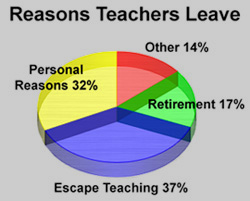What factors do you think influence special education teacher turnover?
Page 1: Teacher Retention and Turnover

Over the last three decades, schools have seen a shortage of qualified special education teachers. A high turnover rate among special education teachers, which has remained relatively stable at around 25% over the past 20 years, contributes to this shortage. For our purposes here, teacher turnover will be used to describe:
- Attrition: Teachers leave the field of education for non-education work (e.g., change careers, stay home with children, retire from profession)
- Transfers: Teachers transfer from special education to general education positions
- Migration: Teachers move to another special education position
Did You Know?
Some districts may have relatively low levels of turnover, while neighboring districts have high levels. High-poverty school districts bear the brunt of the special education teacher shortage. They face higher proportions of unqualified teachers and higher turnover rates than is the case among wealthier districts.
- Fewer faculty have a significant understanding of the students, families, and community
- Investments in professional development are lost
- Collaborative relationships among general and special educators must be rebuilt
Reasons for Teacher Turnover
In order to increase teacher retention, it is helpful for school leaders to understand the reasons that special educators leave their positions. In fact, there are a number of reasons, and these include:
Experience: Teachers are most at-risk of leaving during their first years in the classroom. Some estimates suggest that up to 50% of new teachers leave the profession in the first several years.
Retirement: Given the large number of baby-boomers moving toward retirement, a large proportion of teachers will leave the workforce over the next decade. In addition, many teachers might choose to retire early because of work-related experiences.
Work-related Experiences: Work stress and dissatisfaction are major contributors to teacher turnover. Some commonly cited examples are:
- Lack of support from administrators and colleagues
- Large caseloads
- Non-teaching responsibilities (e.g., excessive paperwork)
- Student behavior
- Accountability requirements
- Lack of opportunity to teach students
- Salary and benefits (although teachers will sometimes choose better working conditions over higher compensation)
Bonnie Billingsley reiterates some of the reasons special education teachers experience work-related stress (time: 1:14).

Bonnie Billingsley, EdD
Professor and Chair, Department of Teaching and Learning
Virginia Tech
Transcript: Bonnie Billingsley EdD
We know that there are several things that create a lot of stress for special educators. One of them is role overload, unrealistic non-teaching demands. A lot of special educators complain about excessive paper work, too many meetings. They often complain that these non-teaching demands really interferes with their teaching responsibilities, and of course teachers want to help kids. That’s why they went into this to begin with, so when they’re forced to spend time doing things that they see as peripheral, unimportant, or redundant then they get discouraged and they feel like they can’t do their jobs well. There’s also caseload issues. Some teachers just have so many kids on their caseload that they feel that they can’t serve them well. Or they have such a diverse caseload; for example, being asked to teach children with four or five disabilities in a lot of different classrooms can also create role stress. Then if you add to that a lack of support from administration, another reason teachers tell us they leave, that really leaves the teacher feeling like where can I go to get help?
Research Shows
 Data indicate that the most common reasons special education teachers leave the profession are to escape teaching, to address personal issues, and to retire.
Data indicate that the most common reasons special education teachers leave the profession are to escape teaching, to address personal issues, and to retire.
(Boe et al., 2008)
Methods for Tracking and Understanding Teacher Turnover
Rates and patterns of teacher turnover may be viewed from national, state, district, school, or program perspectives. Understanding these data can inform school leaders and policymakers about the best strategies for improving teacher retention and reducing turnover rates. School leaders need to make an effort to track the percentage of special education teachers leaving their positions and discover why they have chosen to do so. Three methods they can use to do this are outlined in the table below.
| Method | How to Implement | Guiding Questions |
| Monitoring turnover rates over time | Identify the patterns of leaving in the school or district and compare these patterns with others in the same geographic area. |
|
| Conducting confidential exit surveys or interviews | Look for work-related patterns across teachers and use that information for strategic planning related to increasing teacher retention. |
|
| Asking current teachers to indicate how long they plan to stay | Conduct brief, confidential interviews with teachers and ask about their experiences and plans for the future. |
|